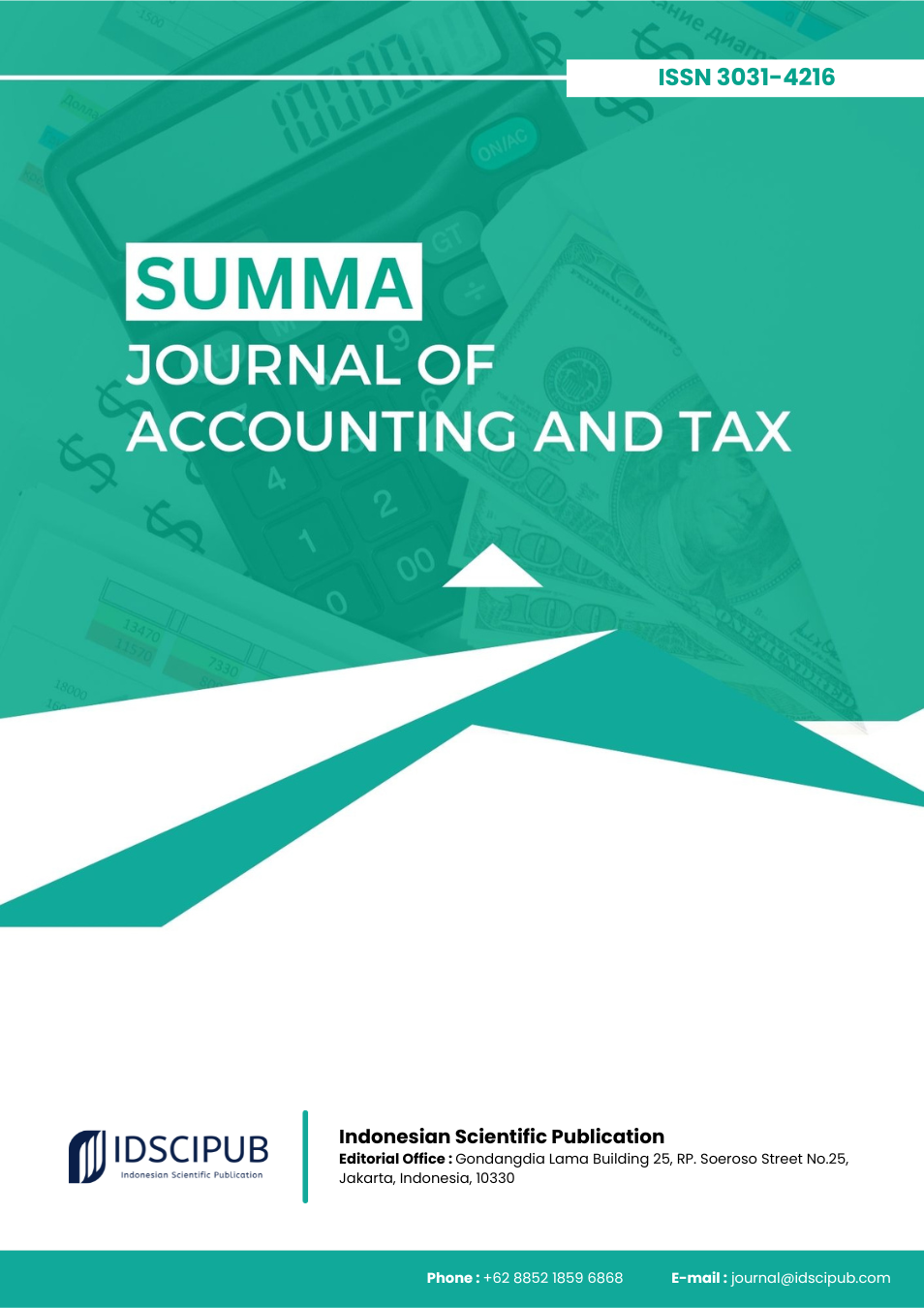Global Insights into Financial Statement Fraud Detection and Prevention
DOI:
https://doi.org/10.61978/summa.v2i1.972Keywords:
Financial Statement Fraud, Fraud Detection Techniques, Corporate Governance, Machine Learning, Forensic Accounting, Audit Committees, Regulatory OversightAbstract
Financial statement fraud undermines the integrity of global financial markets and poses critical challenges to corporate governance. This study conducts a narrative review to synthesize existing knowledge on fraud detection techniques and slished within the last two decades addressing fraud detection models, governance frameworks, and regional variations. Findings reveal that traditional statistical methods such as the Beneish M-Score and Altman Z-Score provide foundational tools but are increasingly supplemented by machine learning and artificial intelligence models, which achieve higher accuracy rates in detecting anomalies. Forensic accounting and data mining further enhance detection capabilities. Governance mechanisms, particularly board independence, audit committees, auditor rotation, and whistleblower protections, emerge as essential for reducing fraud incidence, with regulatory oversight reinforcing these practices in developed markets. However, emerging economies face significant challenges due to weaker institutions and limited adoption of advanced technologies, resulting in higher fraud prevalence. Discussion highlights systemic factors such as regulatory gaps, market pressures, and organizational culture as key contributors to persistent fraud. Policy reforms, technological innovations, and future research integrating human and computational dimensions are recommended to build adaptive frameworks. This review underscores the urgency of combining governance reforms and AI-driven detection systems to safeguard financial reporting integrity globally.
References
Aboud, A., & Robinson, B. (2020). Fraudulent financial reporting and data analytics: An explanatory study from Ireland. Accounting Research Journal, 35(1), 21–36. https://doi.org/10.1108/arj-04-2020-0079 DOI: https://doi.org/10.1108/ARJ-04-2020-0079
Ali, A., Khedr, A., El-Bannany, M., & Kanakkayil, S. (2023). A powerful predicting model for financial statement fraud based on optimized XGBoost ensemble learning technique. Applied Sciences, 13(4), 2272. https://doi.org/10.3390/app13042272 DOI: https://doi.org/10.3390/app13042272
Arboleda, F., Luna, J., & Torres, I. (2018). Fraud detection-oriented operators in a data warehouse based on forensic accounting techniques. Computer Fraud & Security, 2018(10), 13–19. https://doi.org/10.1016/s1361-3723(18)30098-8 DOI: https://doi.org/10.1016/S1361-3723(18)30098-8
Aris, N., Arif, S., Othman, R., & Zain, M. (2015). Fraudulent financial statement detection using statistical techniques: The case of small medium automotive enterprise. Journal of Applied Business Research (JABR), 31(4), 1469. https://doi.org/10.19030/jabr.v31i4.9330 DOI: https://doi.org/10.19030/jabr.v31i4.9330
Arum, E., Wijaya, R., & Wahyudi, I. (2024). Moderation of corporate governance in financial statement fraud investigation with the SCCORE model. Revista De Gestão Social E Ambiental, 18(4), e06265. https://doi.org/10.24857/rgsa.v18n4-136 DOI: https://doi.org/10.24857/rgsa.v18n4-136
Awad, A., Akola, O., Amer, M., & Mousa, E. (2025). Artificial intelligence in financial statement preparation: Enhancing accuracy, compliance, and corporate performance. International Journal of Innovative Research and Scientific Studies, 8(2), 361–374. https://doi.org/10.53894/ijirss.v8i2.5166 DOI: https://doi.org/10.53894/ijirss.v8i2.5166
Bhagat, N. (2024). Artificial intelligence challenges and its impact on detection and prevention of financial statement fraud. pp. 60–80. https://doi.org/10.4018/979-8-3693-0724-3.ch004 DOI: https://doi.org/10.4018/979-8-3693-0724-3.ch004
Burcă, V., Popa, A., Sahlian, D., Traşcă, D., & Bobițan, N. (2022). Modelling the impact of earnings management on the probability of financial statements fraud. Engineering Economics, 33(5), 521–539. https://doi.org/10.5755/j01.ee.33.5.30672 DOI: https://doi.org/10.5755/j01.ee.33.5.30672
Darmawati, D., & Mediaty, M. (2024). Enhancing fraud detection capacities: The role of auditor training, professional skepticism, and integrity in government internal control mechanisms in Indonesia. Revista De Gestão Social E Ambiental, 18(8), e06002. https://doi.org/10.24857/rgsa.v18n8-094 DOI: https://doi.org/10.24857/rgsa.v18n8-094
Esmail, F., Alsheref, F., & Aboutabl, A. (2023). Review of loan fraud detection process in the banking sector using data mining techniques. International Journal of Electrical and Computer Engineering Systems, 14(2), 229–239. https://doi.org/10.32985/ijeces.14.2.12 DOI: https://doi.org/10.32985/ijeces.14.2.12
Faccia, A., McDonald, J., & George, B. (2023). NLP sentiment analysis and accounting transparency: A new era of financial record keeping. Computers, 13(1), 5. https://doi.org/10.3390/computers13010005 DOI: https://doi.org/10.3390/computers13010005
Gepp, A., Kumar, K., & Bhattacharya, S. (2020). Lifting the numbers game: Identifying key input variables and a best-performing model to detect financial statement fraud. Accounting and Finance, 61(3), 4601–4638. https://doi.org/10.1111/acfi.12742 DOI: https://doi.org/10.1111/acfi.12742
Gupta, R., Gupta, S., & Ajekwe, C. (2023). Electronic banking frauds. pp. 166–183. https://doi.org/10.4018/979-8-3693-1190-5.ch009 DOI: https://doi.org/10.4018/979-8-3693-1190-5.ch009
Gupta, S., & Mehta, S. (2020). Feature selection for dimension reduction of financial data for detection of financial statement frauds in context to Indian companies. Global Business Review, 25(2), 323–348. https://doi.org/10.1177/0972150920928663 DOI: https://doi.org/10.1177/0972150920928663
Gupta, S., & Mehta, S. (2021). Data mining-based financial statement fraud detection: Systematic literature review and meta-analysis to estimate data sample mapping of fraudulent companies against non-fraudulent companies. Global Business Review, 25(5), 1290–1313. https://doi.org/10.1177/0972150920984857 DOI: https://doi.org/10.1177/0972150920984857
Huang, L., Abrahams, A., & Ractham, P. (2022). Enhanced financial fraud detection using cost-sensitive cascade forest with missing value imputation. Intelligent Systems in Accounting, 29(3), 133–155. https://doi.org/10.1002/isaf.1517 DOI: https://doi.org/10.1002/isaf.1517
Li, X., Xu, W., & Tian, X. (2014). How to protect investors? A GA-based DWD approach for financial statement fraud detection. https://doi.org/10.1109/smc.2014.6974480 DOI: https://doi.org/10.1109/SMC.2014.6974480
Munteanu, V., Zuca, M., Horaicu, A., Florea, L., Poenaru, C., & Anghel, G. (2024). Auditing the risk of financial fraud using the red flags technique. Applied Sciences, 14(2), 757. https://doi.org/10.3390/app14020757 DOI: https://doi.org/10.3390/app14020757
Naz, I., & Khan, S. (2024). Impact of forensic accounting on fraud detection and prevention: A case of firms in Pakistan. Journal of Financial Crime, 32(1), 192–206. https://doi.org/10.1108/jfc-01-2024-0010 DOI: https://doi.org/10.1108/JFC-01-2024-0010
Nurcahyono, N., Hanum, A., Kristiana, I., & Pamungkas, I. (2021). Predicting fraudulent financial statement risk: The testing Dechow F-Score financial sector company in Indonesia. Universal Journal of Accounting and Finance, 9(6), 1487–1494. https://doi.org/10.13189/ujaf.2021.090625 DOI: https://doi.org/10.13189/ujaf.2021.090625
Ramzan, S., & Lokanan, M. (2024). The application of machine learning to study fraud in the accounting literature. Journal of Accounting Literature, 47(3), 570–596. https://doi.org/10.1108/jal-11-2022-0112 DOI: https://doi.org/10.1108/JAL-11-2022-0112
Soltani, M., Kythreotis, A., & Roshanpoor, A. (2023). Two decades of financial statement fraud detection literature review; combination of bibliometric analysis and topic modeling approach. Journal of Financial Crime, 30(5), 1367–1388. https://doi.org/10.1108/jfc-09-2022-0227 DOI: https://doi.org/10.1108/JFC-09-2022-0227
Tshikovhi, A., Oseifuah, E., & Reynolds, A. (2025). Effectiveness of the fraud triangle model in the detection of financial statement fraud in South African municipalities. Public and Municipal Finance, 14(1), 95–105. https://doi.org/10.21511/pmf.14(1).2025.08 DOI: https://doi.org/10.21511/pmf.14(1).2025.08
Yang, X. (2025). Financial fraud identification and economic impact analysis based on machine vision technology. Journal of Computational Methods in Sciences and Engineering. https://doi.org/10.1177/14727978251346036 DOI: https://doi.org/10.1177/14727978251346036
Yao, J., Pan, Y., Yang, S., Chen, Y., & Li, Y. (2019). Detecting fraudulent financial statements for the sustainable development of the socio-economy in China: A multi-analytic approach. Sustainability, 11(6), 1579. https://doi.org/10.3390/su11061579 DOI: https://doi.org/10.3390/su11061579
Yuan, Y., Wang, Z., & Zhang, S. (2025). Research on financial statement fraud detection method based on support vector machine. https://doi.org/10.3233/atde241371 DOI: https://doi.org/10.3233/ATDE241371







